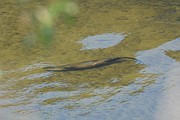River otters: Well adapted for semi-aquatic living in North Idaho
Recently I was traveling along Myrtle Creek on the Kootenai National Wildlife Refuge loop road, when I was surprised by an adult otter swimming in the water below me.
I watched her for about 30 minutes while she was trying to catch a fish to feed her young pups. I focused on her every move, but she kept the pups in a safe hiding place, underwater and back into the river bank and in her den so I never saw them this visit.
The playful North American river otter is well adapted for semi-aquatic living. The mammals have thick, protective fur to help them keep warm while swimming in cold waters. They have short legs, webbed feet for faster swimming, and a long, narrow body and flattened head for streamlined movement in the water. A long, strong trail helps propels the otter through the water. They can stay underwater for as much as eight minutes.
North American river otters have long whiskers, which they use to detect prey in dark or cloudy water, and clawed feet for grasping onto slippery prey. They are very flexible and can make sharp, sudden turns that help them catch fish. Their fur is dark brown over much of the body, and lighter brown on the belly and face.
On land a river otter can run at speeds of up to 15 miles an hour — they can slide even faster. Their playful snow and mud sliding, tail chasing, water play, and snow burrowing activities also serve other purposes — they help strengthen social bonds and let young otters practice hunting techniques.
A river otter can grow three to four feet long, including its tail, and weigh between 11 to 30 pounds. Males are generally larger than females. The tail makes up about a third of their total length.
The North American river otter lives primarily Canada and the United States, except for portions of the Southwest, and in Mexico in the Rio Grande and Colorado River delta areas. They can thrive in any water habitat, such as ponds, marshes, lakes, rivers, and estuaries — in cold, warm, or even high-elevation areas — as long as the habitat provides adequate food.
River otter dens are along the water in abandoned burrows or empty hollows. The dens have entrances underwater so they can be easily accessed from the water. Bobcats, coyotes, raptors, and other large predators will sometimes prey on North American river otters.
River otters eat a variety of aquatic wildlife, such as fish, frogs, birds and their eggs, and reptiles such as turtles. They have also been known to eat aquatic plants and to prey on other small mammals, such as muskrats or rabbits. They have a very high metabolism, so they need to eat frequently.
River otters communicate with whistles, yelps, growls, and screams, as well as touch and body posture. They also scent mark, using scent glands near the base of their tails that produce a strong, musky odor.
They breed in late winter or early spring. Adults generally give birth to between one and three pups, which are blind and helpless when born. They first learn to swim after about two months. River otters generally live alone or in small social groups. They can live eight to nine years in the wild but have lived up to 21 years in captivity.
Enjoy Boundary County’s beauty and its amazing wildlife.



